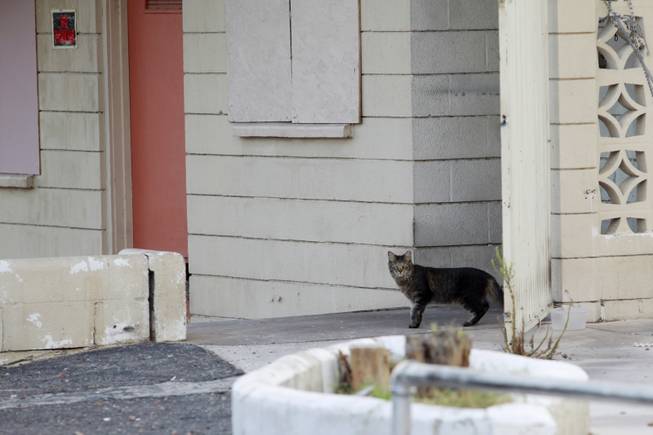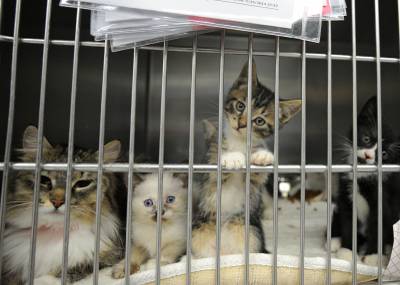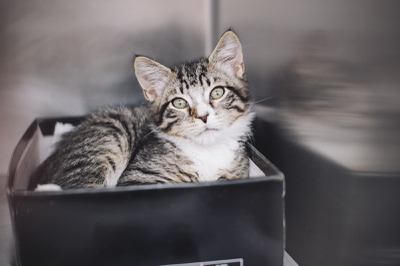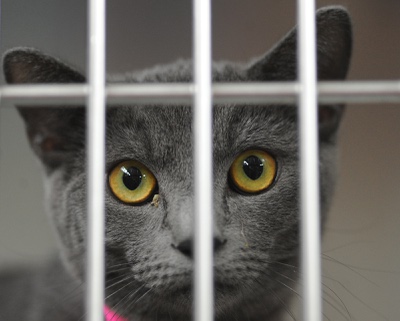
A member of the feral cat colony at the closed White Sands Motel on Friday, July 25, 2014.
Tuesday, Sept. 23, 2014 | 2 a.m.
They’re the smallest, and some people would say sweetest-faced, animals on death row: the thousands of stray kittens and cats taken to the region’s largest animal shelter.
About three-quarters of them will be killed, a number that haunts animal lovers including the people who work and manage the Lied Animal Shelter. The reason: most of the felines were born and have lived outdoors, and will rebel at living inside, and so are not good candidates for adoption. As it is, the Animal Foundation, which operates the shelter, has trouble adopting out all of the domestic cats that it gets.
But a new strategy to reduce the region’s burgeoning stray-cat population — with the bonus of also reducing the number of cats that are euthanized — is being pursued by the Animal Foundation.
The proposal, which will need the approval of Clark County commissioners and the city councils of Las Vegas and North Las Vegas, all of which contract with the Animal Foundation to handle stray animals, calls for cats that are delivered to the Animal Foundation’s shelter to be sterilized, vaccinated and — here’s the twist — to then be returned to where they were found. The Animal Foundation also is working with individual organizations that trap stray cats to sterilize and vaccinate them before releasing them back to the organizations for return to their neighborhoods.
People who hate cats will cringe, but in the end they may understand the rationale:
Sterilized cats in outdoor colonies will not reproduce so, over time and with a growing percentage of neutered or spayed cats in the wild, the number of litters will continue to drop, leading to a decreasing cat population. That strategy is used, for instance, in ridding regions of fruit flies, by introducing sterile fruit flies to the population.
The strategy was proposed by a handful of animal experts and no-kill advocates, including veterinarian Kate Hurley, an animal shelter expert at the University of California, Davis, who were asked by the Animal Foundation to study its practices and make recommendations in how to reduce the numbers of euthanized animals.
The sterilize, vaccinate-and-return proposal was well received by the foundation’s board of directors, according to Christine Robinson, the organization’s executive director.
“If you’re talking about getting the most life-saving bang for your buck, instituting a community cat program like this is where it’s at,” Robinson said. “This is the most important overall recommendation coming out of their evaluation.”
A second part of the cat initiative is to better control the intake of cats so the shelter isn’t overwhelmed by cats at any given time, Robinson said. Persons wanting to bring their cats to the shelter — which by contract must take any and all animals — will be asked to voluntarily schedule the delivery on a day when the animal can best be accommodated.
Someone who brings in a stray cat will be asked to return the cat to where it was found after the animal is sterilized and vaccinated. When animal control officers collect strays, they too will be spayed or neutered, and vaccinated, and returned to where they were found.
“Our intake process includes noting exactly where the cat was found, so when it’s ready to be returned, the officer will know where to take it,” Robinson said.
On average, about 1,200 cats have been brought to the shelter every month this year. About 73 percent of them are euthanized because, even though they are healthy, they don’t tolerate indoor containment.
“We shouldn’t be euthanizing healthy cats,” Robinson said. “But it’s a practice you see all across the country — people bringing in feral or unowned cats that we have to put down. And it hasn’t worked. The cat overpopulation problem has increased. There has to be a better way.”
Campaigns to trap-and-sterilize feral cats are not new. The organization Community Cat Coalition of Clark County, or C5, traps, sterilizes and returns feral cats to their neighborhoods, and also advises people on how to help care for feral cat colonies, which can legally be maintained by residents in Las Vegas and unincorporated Clark County. North Las Vegas Vice Mayor Anita Wood is urging a similar ordinance for her city. Henderson operates its own shelter, where unclaimed animals are euthanized.
County Commissioner Chris Giunchigliani said she is hopeful that fellow commissioners will embrace the Animal Foundation’s plan. “It will take us to the next step in dealing with the overpopulation of cats,” she said. “We’ve either been killing them or letting them keep making more kittens. Now we can get them fixed and bring the numbers down. That makes a lot of sense.”
Said Robinson: “We’ve been spending almost $1 million a year on cats — only to have to end up euthanizing most of them. This will allow us to re-purpose money while saving cats.”




Join the Discussion:
Check this out for a full explanation of our conversion to the LiveFyre commenting system and instructions on how to sign up for an account.
Full comments policy